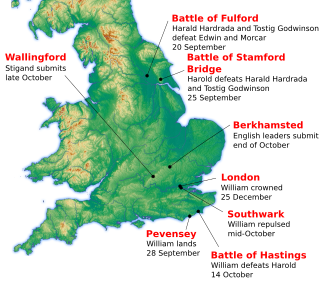 W
WThe Norman Conquest was the 11th-century invasion and occupation of England by an army made up of thousands of Normans, Bretons, Flemish, and men from other French provinces, all led by the Duke of Normandy later styled William the Conqueror.
 W
WThe Accord of Winchester is the 11th-century document that establishes the primacy of the archbishop of Canterbury over the archbishop of York.
 W
WÆlfwine of Warwick was a Sheriff of Warwickshire under William the Conquorer, and one of the few Anglo-Saxons to retain their lands after the conquest.
 W
WAimery IV viscount of Thouars was a companion of William the Conqueror on his Invasion of England in 1066.
 W
WBattle Abbey is a partially ruined Benedictine abbey in Battle, East Sussex, England. The abbey was built on the site of the Battle of Hastings and dedicated to St Martin of Tours. It is a Scheduled Monument.
 W
WBattle is a small town and civil parish in the local government district of Rother in East Sussex, England. It lies 50 miles (80 km) south-east of London, 30 miles (50 km) east of Brighton and 20 miles (30 km) east of Lewes. Hastings is to the south-east and Bexhill-on-Sea to the south. Battle is in the designated High Weald Area of Outstanding Natural Beauty, and is a tourist destination and commuter town for white collar workers in the City of London. The parish population was 6,048 according to the 2001 census, increasing to 6,673 with the 2011 Census.
 W
WThe Bayeux Tapestry is an embroidered cloth nearly 70 metres (230 ft) long and 50 centimetres (20 in) tall that depicts the events leading up to the Norman conquest of England concerning William, Duke of Normandy, and Harold, Earl of Wessex, later King of England, and culminating in the Battle of Hastings. It is thought to date to the 11th century, within a few years after the battle. It tells the story from the point of view of the conquering Normans but is now agreed to have been made in England.
 W
WThe Bayeux Tapestry tituli are captions embroidered on the Bayeux Tapestry describing scenes portrayed on the tapestry. These depict events leading up to the Norman conquest of England concerning William, Duke of Normandy, and Harold, Earl of Wessex, later King of England, and culminating in the Battle of Hastings. The tituli are in Medieval Latin.
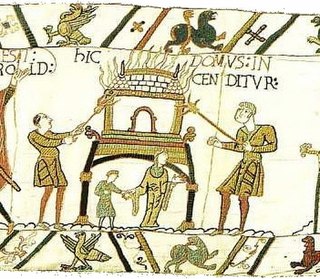 W
WThe Burning of Southwark was a battle fought in Southwark during the Norman Conquest of England in October 1066.
 W
WThe Earldom of Chester was one of the most powerful earldoms in medieval England, extending principally over the counties of Cheshire and Flintshire. Since 1301 the title has generally been granted to heirs apparent to the English throne, and from the late 14th century it has been given only in conjunction with that of Prince of Wales.
 W
WWilliam the Conqueror had men of diverse standing and origins under his command at the Battle of Hastings in 1066. With these and other men he went on in the five succeeding years to conduct the Harrying of the North and complete the Norman conquest of England.
 W
WIn England, Wales and Ireland a county palatine or palatinate was an area ruled by a hereditary nobleman enjoying special authority and autonomy from the rest of a kingdom or empire. The name derives from the Latin adjective palātīnus, "relating to the palace", from the noun palātium, "palace". It thus implies the exercise of a quasi-royal prerogative within a county, that is to say a jurisdiction ruled by an earl, the English equivalent of a count. A duchy palatine is similar but is ruled over by a duke, a nobleman of higher precedence than an earl or count.
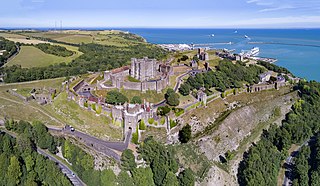 W
WDover Castle is a medieval castle in Dover, Kent, England. It was founded in the 11th century and has been described as the "Key to England" due to its defensive significance throughout history. Some sources say it is the largest castle in England, a title also claimed by Windsor Castle.
 W
WEaldred v Malet was a court case of early English law between Ealdred and William Malet that occurred circa 1068. Ealdred was seeking the return of lands taken by the Sherriff during the conquest.
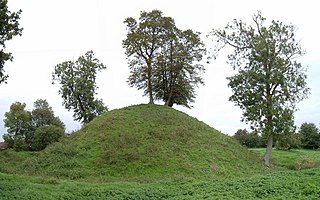 W
WWilliam d'Ecouis was an early Anglo-Norman baron, who is mentioned in the Domesday Book of 1086 as a substantial holder of land and manors.
 W
WEdward the Confessor was one of the last Anglo-Saxon kings of England. Usually considered the last king of the House of Wessex, he ruled from 1042 to 1066.
 W
WThe Battle of Fulford was fought on the outskirts of the village of Fulford near York in England, on 20 September 1066, when King Harald III of Norway, also known as Harald Hardrada, and Tostig Godwinson, his English ally, fought and defeated the Northern Earls Edwin and Morcar.
 W
WGrestain Abbey was an 11th-Century Benedictine monastery near the town of Fatouville-Grestain, which is located in the modern-day Eure département of Upper Normandy, France. The abbey was in the Catholic Diocese of Lisieux. Closely associated with the family of William, Duke of Normandy, the abbey was instrumental in the Normans taking control over the Church in England in the centuries following the Norman Conquest of England, establishing new churches and priories in England, and Abbots of Grestain ordained many English priests. Many churches mentioned in the Domesday Book of 1086 cite Grestain as the founding establishment.
 W
WHarold Godwinson, also called Harold II, was the last crowned Anglo-Saxon king of England. Harold reigned from 6 January 1066 until his death at the Battle of Hastings, fighting the Norman invaders led by William the Conqueror during the Norman conquest of England. His death marked the end of Anglo-Saxon rule over England.
 W
WThe Harrying of the North refers to a series of campaigns waged by William the Conqueror in the winter of 1069–70 to subjugate northern England, where the presence of the last Wessex claimant, Edgar Atheling, had encouraged Anglo-Danish rebellions. William paid the Danes to go home, but the remaining rebels refused to meet him in battle, and he decided to starve them out by laying waste to the northern shires using scorched earth tactics, especially in the city of York, before relieving the English aristocracy of their positions, and installing Norman aristocrats throughout the region.
 W
WThe Battle of Hastings was fought on 14 October 1066 between the Norman-French army of William, the Duke of Normandy, and an English army under the Anglo-Saxon King Harold Godwinson, beginning the Norman conquest of England. It took place approximately 7 mi (11 km) northwest of Hastings, close to the present-day town of Battle, East Sussex, and was a decisive Norman victory.
 W
WSenlac Hill is the generally accepted location in which Harold Godwinson deployed his army for the Battle of Hastings on 14 October 1066. It is located near what is now the town of Battle, East Sussex. The name Senlac was popularised by the Victorian historian E.A. Freeman, based solely on a description of the battle by the Anglo-Norman chronicler Orderic Vitalis. Freeman went on to suggest that the Normans nicknamed the area Blood lake as a pun on the English Sand lake.
 W
WHereward the Wake (c.1035 – c.1072) was an Anglo-Saxon nobleman and a leader of local resistance to the Norman Conquest of England. His base, when leading the rebellion against the Norman rulers, was the Isle of Ely in eastern England. According to legend he roamed the Fens, which nowadays covers the parts of the modern counties of Cambridgeshire, Lincolnshire and Norfolk, leading popular opposition to William the Conqueror.
 W
WThe History of the Norman Conquest of England: Its Causes and Its Results is a six-volume study of the Conquest by Edward A. Freeman, published between 1867 and 1879. Recognised by critics as a major work of scholarship on its first publication, it has since proved unpopular with readers, many of whom were put off by its enormous length and copious detail. Academics have often criticized it for its heavily Whig treatment of the subject, and its glorification of Anglo-Saxon political and social institutions at the expense of their feudal successors, but its influence has nevertheless been profound, many Anglo-Norman historians of modern times having come around to some of Freeman's main conclusions.
 W
WLanfranc was a celebrated Italian jurist who renounced his career to become a Benedictine monk at Bec in Normandy. He served successively as prior of Bec Abbey and abbot of St Stephen in Normandy and then as Archbishop of Canterbury in England, following its Conquest by William the Conqueror. He is also variously known as Lanfranc of Pavia, Lanfranc of Bec, and Lanfranc of Canterbury.
 W
WThe Oath of Salisbury refers to an event in August 1086 when William I of England summoned his tenants-in-chief and "landowning men of any account to William I, 'The Conqueror'" to Old Sarum where they swore allegiance to him and to be faithful against all other men. The oath was demanded at a time of crisis when 'The Conqueror' was facing revolt and invasion. There seems little doubt that it was intended as a practical assurance and reminder rather than as a constitutional statement.
 W
WWilliam I (Willame) de Percy (d.1096/9), 1st feudal baron of Topcliffe in North Yorkshire, known as Willame als gernons, was a Norman nobleman who arrived in England immediately after the Norman Conquest of 1066. He was the founder of the powerful English House of Percy, Earls of Northumberland, and Dukes of Northumberland, a great historical House of England "that, like Caesar's, has been artificially preserved (twice) to the present time". The male line ended in 1174/5 on the death without male progeny of his grandson William II de Percy, but the surname "Percy" was re-adopted by the latter's younger grandson Richard de Louvain (d.1244), whose own "Percy" descendants again failed in the male line in 1670 on the death of Joceline Percy, 11th Earl of Northumberland, and was again re-adopted by the latter's great-grand-daughter's husband Sir Hugh Smithson, 4th Baronet (c.1714-1786), created Duke of Northumberland, whose descendants survive today.
 W
WPevensey Castle is a medieval castle and former Roman Saxon Shore fort at Pevensey in the English county of East Sussex. The site is a Scheduled Monument in the care of English Heritage and is open to visitors. Built around 290 AD and known to the Romans as Anderitum, the fort appears to have been the base for a fleet called the Classis Anderidaensis. The reasons for its construction are unclear; long thought to have been part of a Roman defensive system to guard the British and Gallic coasts against Saxon pirates, it has more recently been suggested that Anderitum and the other Saxon Shore forts were built by a usurper in an ultimately unsuccessful attempt to prevent Rome from reimposing its control over Britain.
 W
WThe Benedictine Priory of St Nicholas or just St Nicholas Priory was a Benedictine monastery founded in Exeter, England, in 1087. At the Dissolution of the Monasteries the church and chapter house range were pulled down but the domestic buildings were left intact. Parts of the north and west ranges of the monastery survive with the west range now being a museum owned by Exeter Historic Buildings Trust.
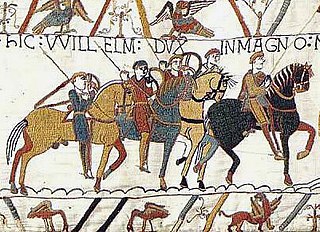 W
WTaillefer was the surname of a Norman jongleur (minstrel), whose exact name and place of birth are unknown. He travelled to England during the Norman conquest of England of 1066, in the train of William the Conqueror. At the Battle of Hastings, Taillefer sang the Chanson de Roland at the English troops while juggling with his sword. An English soldier ran out to challenge him and was killed by Taillefer, who then charged the English lines alone while singing and was engulfed, killing at least four more English in the process. Strangely, Taillefer is not depicted, by name at least, on the Bayeux Tapestry.
 W
WÆlfwine of Warwick was a Sheriff of Warwickshire under William the Conquorer, and one of the few Anglo-Saxons to retain their lands after the conquest.
 W
WTurold of Bayeux, was one of the Norman knights known from both the Bayeux tapestry and Domesday Book. Turold was named on the Bayeux tapestry, and depicted as a messenger. He is believed to have been a vassal of Odo of Bayeux, Bishop of Bayeux and is recorded as holding land from Odo in Kent in the Domesday Book in 1087.
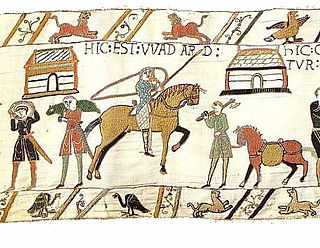 W
WWadard was an 11th century Norman nobleman who is mentioned in Domesday Book, and is depicted in the Bayeux Tapestry.
 W
WWilliam of Jumièges was a contemporary of the events of 1066, and one of the earliest writers on the subject of the Norman conquest of England. He is himself a shadowy figure, only known by his dedicatory letter to William the Conqueror as a monk of Jumièges. Since he also mentions that he was an eyewitness of some events from the reign of Duke Richard III (1026-7), it seems reasonable to assume that he was born some time about the year 1000. He probably entered the monastery during the first quarter of the eleventh century and received his education from Thierry de Mathonville. According to Orderic Vitalis, William's nickname was "Calculus". The meaning behind this nickname is unknown. His death, after 1070, is unrecorded. He was a Norman writing from a Norman point of view. Although only a monk with evidently no military training, he wrote with pride in the accomplishments of his people.